I have been growing ornamental plants for quite some time, but Hibiscus was not among my favorites. The main reason being the short life of the bloom which lasts only a day. Some interest was, however, created when my gardening mentor, Kanai Samadder (I call hi Kanaida), started hybridizing Hibiscus. His noteworthy creations are over 12 new varieties, but he named only a few, such as Nivedita, Swapna and Ayon. He also infused in me the interest of hybridizing and our joint outcomes were two varieties named ‘Vishnu’ and ‘Monoranjan’; the latter named after my father. Gradually many varieties of Hibiscus started being available in open flower market, their size and color attracted me, and so started my tryst with Hibiscus.
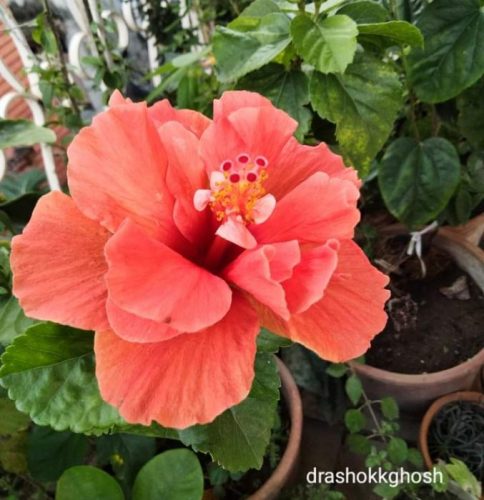
Hibiscus is a genus, of which 2 species are mainly grown in West Bengal, Hibiscus rosa sinesnis, locally known as ‘Jaba‘ and Hibiscus mutabilis (Sthal Padma). In this note, we will be discussing Hibiscus Rosa sinesnis (Jaba) only.
During one of his visits to my home, my close friend Kanchan saw my collection of Hibiscus and quipped, “Babuda, I see you have many ordinary varieties also.”
— “Yes, but you must admit that they have a unique rustic beauty and we grow plants for beauty, be it ordinary or not. Moreover, these blooms are offered to deities at the time of worship as well. Don’t you feel that it gives immense pleasure if you can worship your god with home-grown flowers?”
— “You’re right Babuda and now I understand your point. I am also thinking of growing some Hibiscus.”
— “You should. There should be some permanent plants; otherwise your roof garden would look bland after the seasonal flowers are gone.”
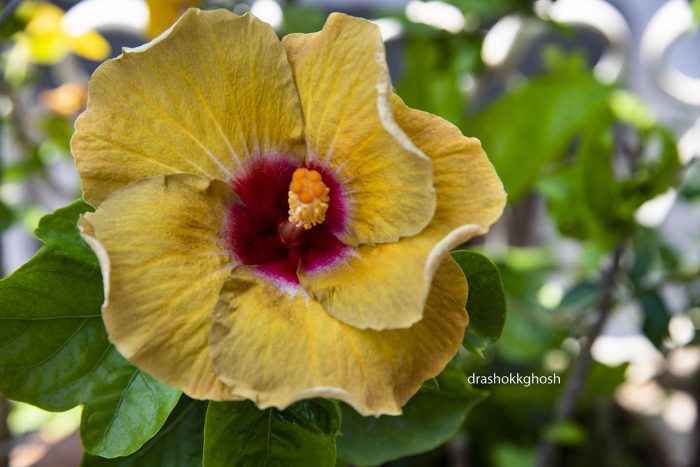
— “Perfect truth. So please give me some useful suggestions about growing Hibiscus.”
— “Listen Kanchan, I’ve told you earlier about Dahlia. You see, the basic drainage system of the pot would be the same as in the case of Hibiscus. Since Hibiscus is also a sun-loving plant, it needs at least 6 – 8 hours of direct sunlight a day.”
— “Tell me how to prepare the soil for Hibiscus plantation?”
— “That’s a good question and a primary issue as well. You see that after assimilating many formulae and suggestions, I have settled on my own recipe of Hibiscus compost and my prescription is as follows:
Loamy Soil: 5 potful (of 8 inches diameter pot)
Vermicompost: 250 grams
Bone dust: 1000 grams
Horn Meal: 250 grams
Mustard Oil Cake: 250 grams
Neem Oil Cake: 250 grams
Super Phosphate: 250 grams
Trace Element (as Tracel/Mobomin): 25 grams
Fungicide (as Blitox/Saaf): 50 grams
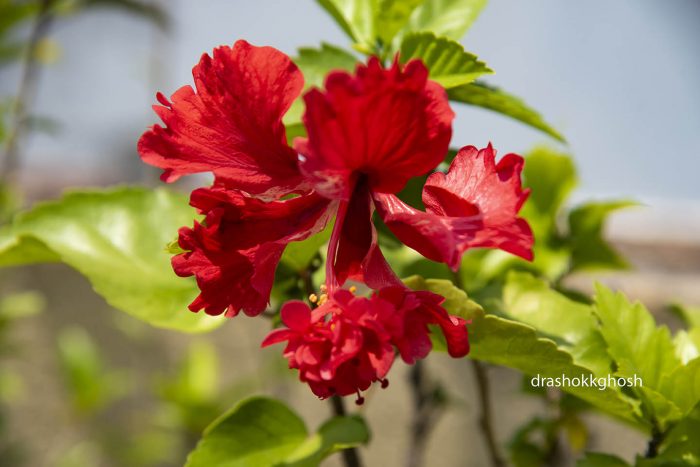
Mix the above ingredients well, cover it with a polythene sheet. The mixture should be sprinkled with water now and then in order to prevent drying and at the same time turned over up and down frequently. This mixture should be kept for at least 15 days before use .”
— “Babuda, don’t you use coco peat?”
— “No, I don’t use it anymore. Because I noticed that during rain it caused water stagnation in the flower pot and most of my plants succumbed.”
— “Do I need to take any other precaution during planting new plants?”
— “Yes, sometimes you may get plants in net pots. Some cut the net pot, but I would suggest not going for tearing it or removing it. It may damage the roots. Plant it as it is, initially in a pot having 6″ diameter, there will not occur any harm. You may re-pot it next year in a larger pot.”
— “Is there anything special in watering?”
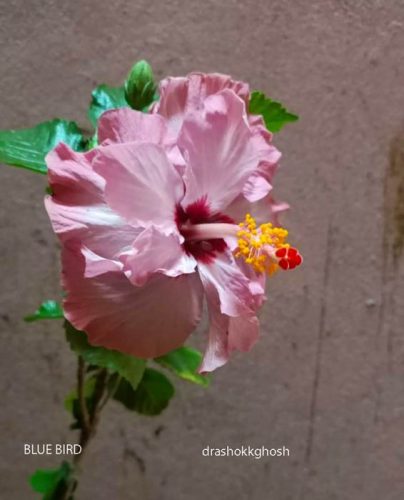
— “Not as such, do what you do with other plants. Water in the early morning or after 7.00 pm. Soil should be moist to the bottom, but water stagnation should be avoided. Make it a point to bathe the plants by spraying with water daily. This will remove any accumulated dust and wash off any pest.”
— “I have heard that after the bloom gets withered, the flower should be removed.”
— “You have heard right. After withering of the flower, the flowering stem should be cut back to the next node, to keep the plant healthy. And in this context, let me mention that you need to prune the plants at least once a year to maintain proper shape of the plant and help it gain vigor.”
— “When should I prune the plants?”
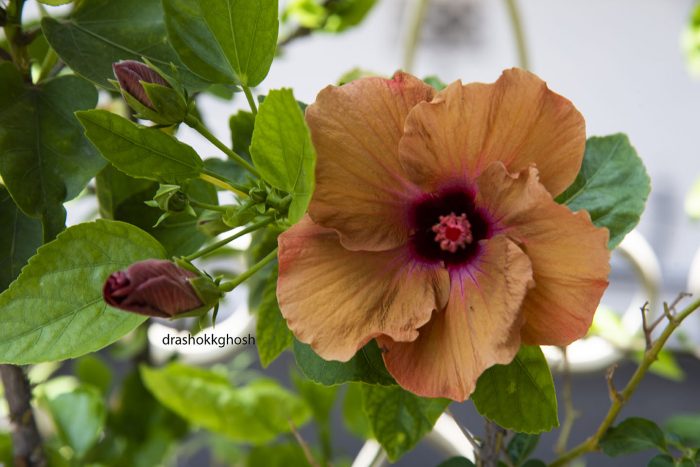
— “So far I’m concerned, I generally prune about one to two months after re-potting. I generally re-pot once the winter has gone by, say in late February or March. While repotting, remove the plant with the soil from the pot, then remove about half the soil making the roots bare. Cut back the roots with clean secateurs and pot the plant again in fresh compost. Keep the re-potted plant in semi shade for a few days and water thoroughly. Spray with fungicide solution.”
— “That means, you prune your plants in April, May.”
— “Yes, while pruning, cut off all dead or weak branches, and prune in such a manner so that the plant would look bushy and attractive when new branches emerge. Also keep in mind not to prune weak plants. After pruning, seal the cut ends with a paste of fungicide to avoid infestation by fungus.”
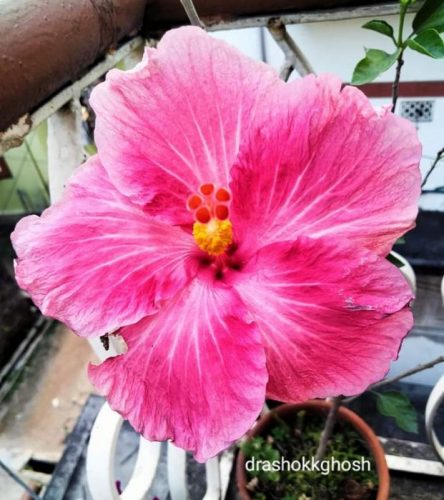
— “Babuda, if for any reason, I cannot re-pot, do I have to add manure?”
— “Yes, it appears that you are serious and conscious. Now listen, I generally prepare a mulching mixture in advance with Vermicompost (500 grams), Bone Meal (250 gms,) Horn Meal (250 gms,), Mustard oil cake (250 gms.), Neem Oil Cake (250 gms,), N:P:K::0:0:50 (20 gms), Trace Element (20 gms), Fungicide (25 gms.). I store it for about 15 days after mixing it thoroughly. Loosen the soil along the periphery of the pot, put about one handful of this mulching mixture in the burrow so created, and cover it up with soil.”
— “Do I need to apply any manure in between as supplemental feed?”
— “You can use decomposed mustard oil cake in liquid form every 15 days after repotting. You can prepare this liquid manure by keeping 100 gms of mustard oil cake in 1 liter of water for 3 – 4 days. Sieve this liquid and add 9 liters of water to it. This diluted manure should be used on soil.”
— “What pesticides should I use?”
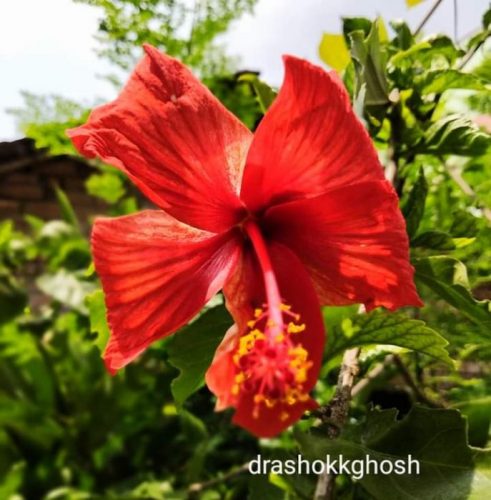
— “Yes, you need to know that too. You should use at least 2 insecticides viz. Confidor ( 0.75 ml / liter) and Rogor (2 ml/ liter). Spray these insecticides alternately at an interval of 15 days. You should also use fungicide at regular intervals especially after pruning and repotting.”
–“Babuda, now tell me, will these measures take care of mealy bugs as well?”
— “When you come across white wooly insects on stems or leaves, you know that those are mealy bugs. If those are present in small numbers, you can simply rub them off with cotton soaked in a mild detergent. If heavily infested, remove the affected branch and burn it. Alternatively, you can spray Aktara. During Covid times, I have seen that Alcohol (Sanitizer spray) also works well.”
— “There are so many varieties of Hibiscus available in the market today. Babuda, are all those imported?”
— “Some of them are imported. Apart from the commonly available ones, there are Tropical, Pune, Bangalore and Australian varieties. Some of these plants are also grafted. During scorching sunshine you may have to provide some shade by using a green mesh cover.”
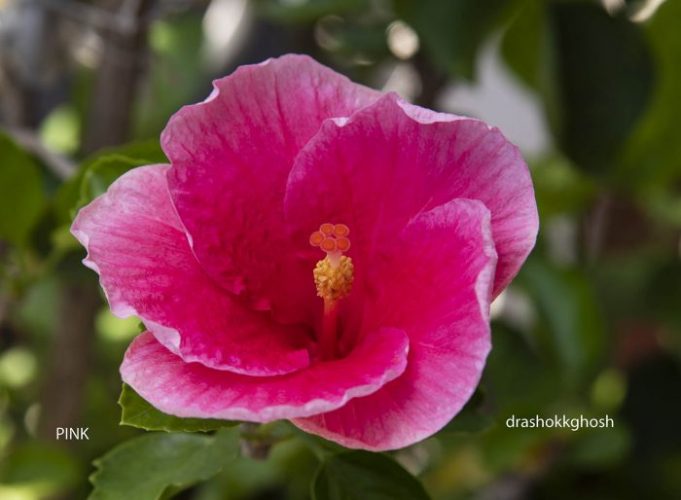
— “We have some red hibiscus at our home at Halisahar, where the stamens have become petals in tufts. We call them Tufted Hibiscus.”
— “Yes, I have seen such flowers. They also come in yellow color. By the way, can you give me some branches of that plant?”
— “Sure, why not. You must be thinking about growing plants out of those branches, I presume.”
— “Rightly guessed. You can also multiply your plants. Cut a segment of semi hardwood stem. Cut off the bark from the bottom end, apply rooting hormone to that end and plant in sand or plain soil. Keep the plant in semi shade and water. It will be rooted in 15 – 20 days. You can make cuttings any time, but they strike roots better during monsoon.”
— “Babuda, please visit our home at Halisahar. We would be very happy and you can collect suitable cuttings at that time.”
— “Once I’ve heard, I shall definitely go, more so because of the delicacies cooked by Masima.”
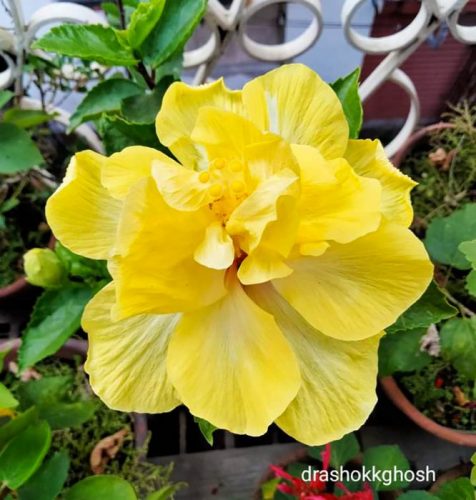
At this time Amarnath da entered. “Oh! I smell a mouth smacking aroma coming from the kitchen. Chitrita, what are you cooking? Oh, I see it is Potoler Dolma (a typical Bengali delicacy, preparation of stuffed pointed gourd).”
Amarnathda has an uncanny ESP (Extra Sensory Perception) regarding gastronomic affairs; he is always present at the right place at the right moment. After being satisfied about the menu, he quipped, “So, you are discussing Hibiscus. Nice flowers indeed. But do you know that Red Hibiscus is the National Flower of Malaysia? The red petals symbolize courage and valor of the Malaysian people and five petals represent the five Rukun Negra of Malaysia. They are Belief in God, Loyalty to King and Country, Supremacy of the Constitution, Rule of Law, Good behavior and morality. So you see, we are worshiping our Goddess Kali with the National Flower of Malaysia. Isn’t that interesting?”
Images courtesy: Dr Ashok Kr Ghosh & Joy Biswas
Ashok Kr Ghosh is a Gynecologist by profession. He is also a Mountaineer and Traveler and amateur photo artist. He is the recipient of several awards including Honourable Mention, Lalit Kala Academy Award, Excellence Honors from ‘Federation International de la Arte Photograhoque’.
Dr Ghosh is also a Naturalist specialising in Ornamental Floriculture and appears as Judge in horticulture exhibitions. His articles are frequently published in leading Bengali periodicals and magazines.





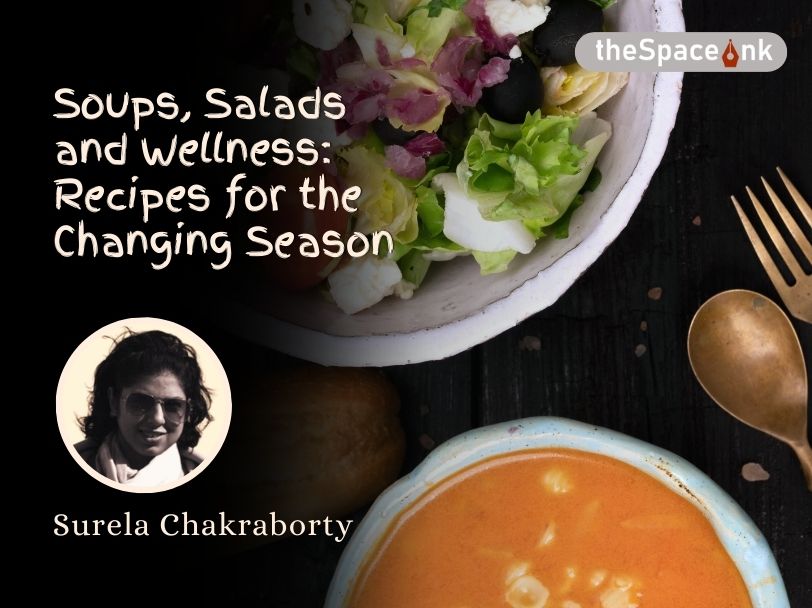



16 Responses
Ashokda, thank you very much for sharing such nice information. I also keep some interest in this subject, so i really loved it.
Thank you Partha. Someday, we may exchange our experiences.
Such simple words to explain complex subjects, a bug salute to Dr. Ashok Kumar Ghosh.
Thank you Partha. Someday, we may exchange our experiences.Thak you Saugata for your kind words.
Such simple words to explain complex subjects, a big salute to Dr. Ashok Kumar Ghosh.
Very informative and exhaustive
An amateur garderner would get all the information he/she needs. Awesome
Thank you Prantik for your kind words.
Excellent
Thank you Pawan for your kind words.
Just by reading this lucidly written article on hibiscus (Jaba variety) anyone would gain considerable degree of expertise. Absolutely fantastic.
Thank you Swapan for your supportive input, as you give always. Thank you again.
So much I knew from this informative yet lucid write up.
Thank you Sharba. Nice that you liked it.
Wounderful heart touching image.
Wonderful to see that your passion for nature is still undiminished, even after all the years that have passed since you showed us way back in 1979 the birds and fishes that you so lovingly looked after in your home.